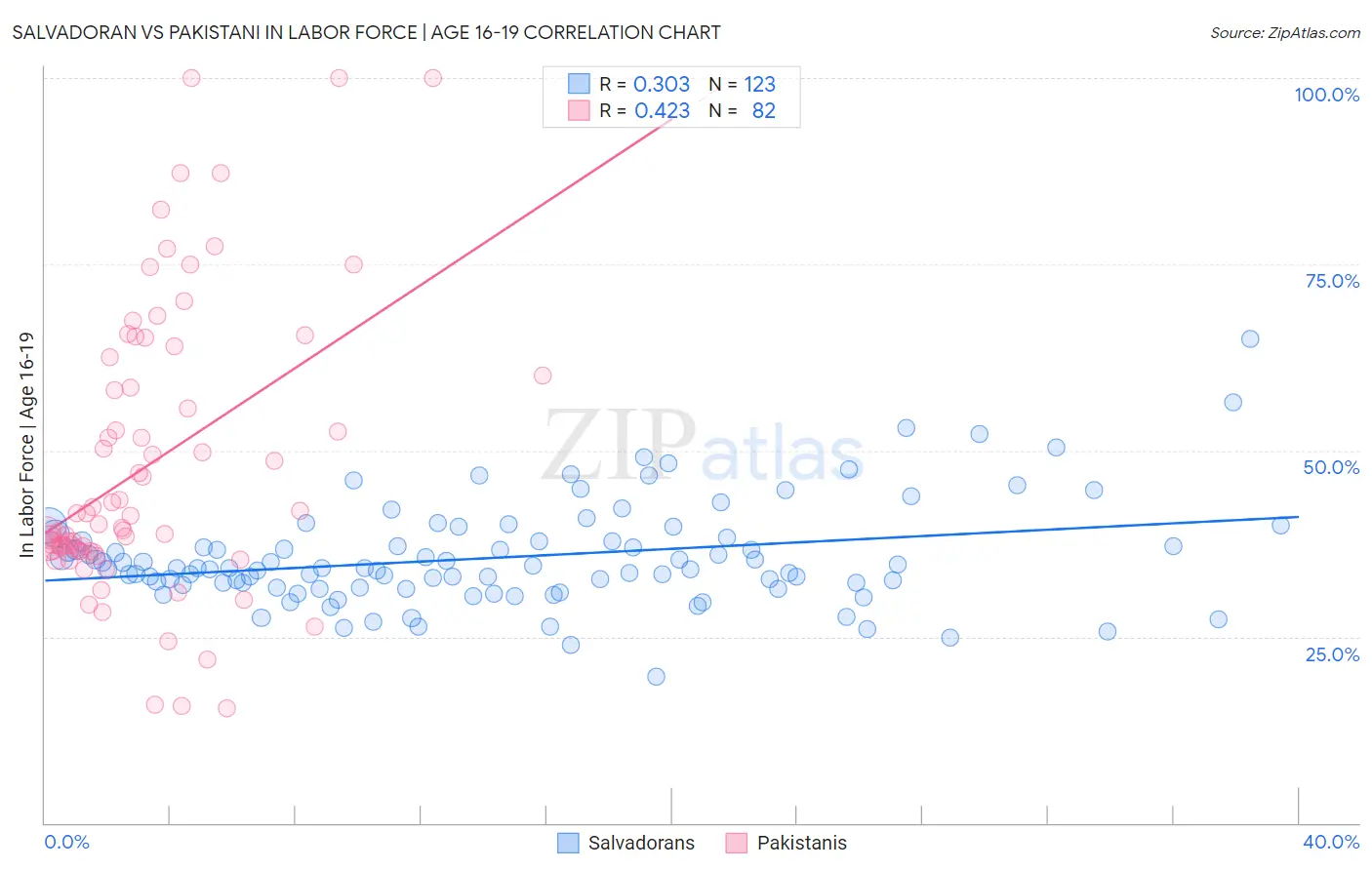Salvadoran vs Pakistani In Labor Force | Age 16-19
COMPARE
Salvadoran
Pakistani
In Labor Force | Age 16-19
In Labor Force | Age 16-19 Comparison
Salvadorans
Pakistanis
34.5%
IN LABOR FORCE | AGE 16-19
1.1/ 100
METRIC RATING
261st/ 347
METRIC RANK
37.6%
IN LABOR FORCE | AGE 16-19
89.5/ 100
METRIC RATING
143rd/ 347
METRIC RANK
Salvadoran vs Pakistani In Labor Force | Age 16-19 Correlation Chart
The statistical analysis conducted on geographies consisting of 398,452,948 people shows a mild positive correlation between the proportion of Salvadorans and labor force participation rate among population between the ages 16 and 19 in the United States with a correlation coefficient (R) of 0.303 and weighted average of 34.5%. Similarly, the statistical analysis conducted on geographies consisting of 335,000,628 people shows a moderate positive correlation between the proportion of Pakistanis and labor force participation rate among population between the ages 16 and 19 in the United States with a correlation coefficient (R) of 0.423 and weighted average of 37.6%, a difference of 8.8%.

In Labor Force | Age 16-19 Correlation Summary
| Measurement | Salvadoran | Pakistani |
| Minimum | 19.7% | 15.4% |
| Maximum | 65.0% | 100.0% |
| Range | 45.3% | 84.6% |
| Mean | 35.6% | 48.1% |
| Median | 34.2% | 40.7% |
| Interquartile 25% (IQ1) | 31.6% | 36.5% |
| Interquartile 75% (IQ3) | 37.9% | 60.0% |
| Interquartile Range (IQR) | 6.3% | 23.5% |
| Standard Deviation (Sample) | 6.9% | 19.2% |
| Standard Deviation (Population) | 6.9% | 19.1% |
Similar Demographics by In Labor Force | Age 16-19
Demographics Similar to Salvadorans by In Labor Force | Age 16-19
In terms of in labor force | age 16-19, the demographic groups most similar to Salvadorans are Hispanic or Latino (34.5%, a difference of 0.010%), Egyptian (34.5%, a difference of 0.040%), Burmese (34.5%, a difference of 0.050%), Immigrants (34.6%, a difference of 0.12%), and Immigrants from Egypt (34.6%, a difference of 0.14%).
| Demographics | Rating | Rank | In Labor Force | Age 16-19 |
| Bahamians | 1.4 /100 | #254 | Tragic 34.6% |
| Peruvians | 1.4 /100 | #255 | Tragic 34.6% |
| Immigrants | South Central Asia | 1.3 /100 | #256 | Tragic 34.6% |
| Immigrants | Egypt | 1.2 /100 | #257 | Tragic 34.6% |
| Thais | 1.2 /100 | #258 | Tragic 34.6% |
| Immigrants | Immigrants | 1.2 /100 | #259 | Tragic 34.6% |
| Egyptians | 1.2 /100 | #260 | Tragic 34.5% |
| Salvadorans | 1.1 /100 | #261 | Tragic 34.5% |
| Hispanics or Latinos | 1.1 /100 | #262 | Tragic 34.5% |
| Burmese | 1.1 /100 | #263 | Tragic 34.5% |
| Immigrants | Uruguay | 0.9 /100 | #264 | Tragic 34.4% |
| Immigrants | El Salvador | 0.7 /100 | #265 | Tragic 34.3% |
| Immigrants | Malaysia | 0.7 /100 | #266 | Tragic 34.3% |
| Immigrants | Peru | 0.5 /100 | #267 | Tragic 34.2% |
| Immigrants | Asia | 0.5 /100 | #268 | Tragic 34.1% |
Demographics Similar to Pakistanis by In Labor Force | Age 16-19
In terms of in labor force | age 16-19, the demographic groups most similar to Pakistanis are Japanese (37.5%, a difference of 0.020%), Paiute (37.5%, a difference of 0.020%), Sierra Leonean (37.6%, a difference of 0.030%), Immigrants from Western Europe (37.5%, a difference of 0.070%), and Brazilian (37.5%, a difference of 0.10%).
| Demographics | Rating | Rank | In Labor Force | Age 16-19 |
| Australians | 93.2 /100 | #136 | Exceptional 37.8% |
| Cajuns | 93.2 /100 | #137 | Exceptional 37.8% |
| Comanche | 91.9 /100 | #138 | Exceptional 37.7% |
| Immigrants | Moldova | 91.9 /100 | #139 | Exceptional 37.7% |
| Estonians | 91.7 /100 | #140 | Exceptional 37.7% |
| Syrians | 90.7 /100 | #141 | Exceptional 37.6% |
| Sierra Leoneans | 89.7 /100 | #142 | Excellent 37.6% |
| Pakistanis | 89.5 /100 | #143 | Excellent 37.6% |
| Japanese | 89.3 /100 | #144 | Excellent 37.5% |
| Paiute | 89.3 /100 | #145 | Excellent 37.5% |
| Immigrants | Western Europe | 88.9 /100 | #146 | Excellent 37.5% |
| Brazilians | 88.7 /100 | #147 | Excellent 37.5% |
| Romanians | 87.3 /100 | #148 | Excellent 37.5% |
| Native Hawaiians | 85.0 /100 | #149 | Excellent 37.4% |
| Tsimshian | 84.7 /100 | #150 | Excellent 37.4% |